Contents
Day 9: Filadelfia coffee plantation
I am thankful for investing time into packing my bags last night, this morning all that remains is my pyjamas, toiletries and the contents of the rooms lockbox which will go in my small pack anyway.
Ruth still isn’t well poor thing, so I enjoy the final included breakfast alone. We join our Intrepid tour this evening so we will be leaving the comforts of Hotel Candelaria for a hotel in town. I haven’t worked out how we’re getting there yet.
I set off early on the direct route into town, noting the turn I had missed the previous day, with the intention of finalising our tickets for our trip to Lake Atitlan tomorrow and booking a chocolate workshop for the afternoon. However all I actually have time to do is drop off laundry and finalise Atitlan, with a smidge of time left to pop by Fernando’s for a coffee before digging out my map to locate the pickup point for the coffee tour.
Naturally I needn’t have worried, as with every other pickup this trip they run on their own schedule of time and are twenty-five minutes late. Checkout is 1pm and the travel agency told me the coffee tour is an hour so I’m not concerned.
Now for anyone who doesn’t know me, it is probably pretty evident by now that I love my coffee. For anyone who missed the memo let me hold up a neon sign for you.
I love coffee!
I’m a two cup per day minimum, more if I’m not working or actually need to sleep at a sensible time. My morning doesn’t begin without coffee and I don’t drink the crap stuff. Unless I am desperate and there is nothing else available. Consuming coffee is the service I do everyone around me.
Hence it’s no real surprise that given the chance I want to go to a coffee plantation.
But enough about me…
A coffee journey
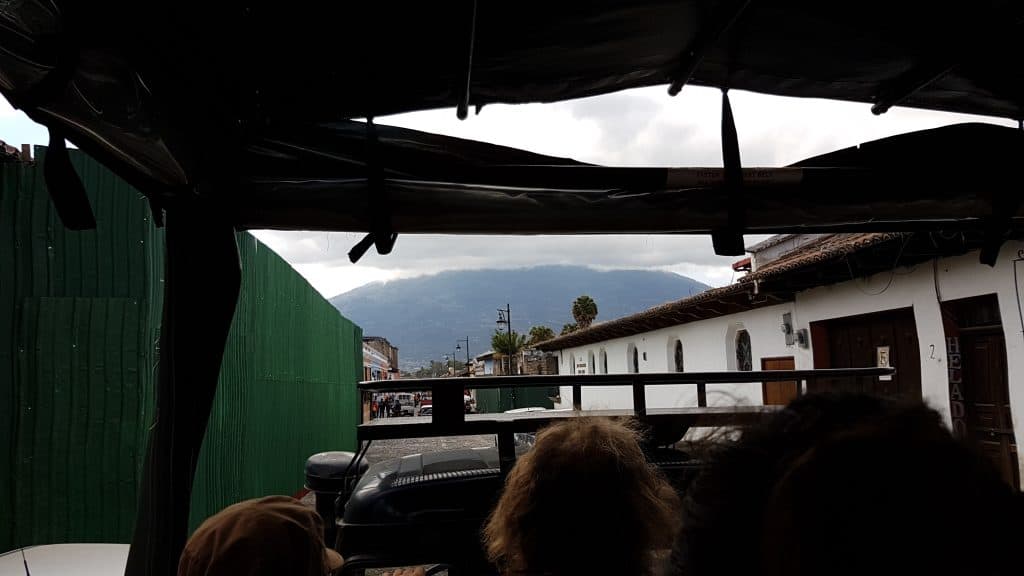
A vehicle something like an African safari bus finally arrives to collect me and proceeds to bump along the Antiguan streets. It is a short trip to the coffee plantation in the next town. We soon pull up to the entrance of a grand sprawling estate that resembles something straight out of a movie. We trundle in through the gates and along the dirt driveway, stopping in front of a building housing a restaurant, gift shop and reception where a few of the passengers from my bus are handing over money. An attendant fastens a band around my wrist when I show my ticket. A man who turns out to be our guide ushers us back onto the bus, which he drives along the dirt roads of the property. We climb down when we stop in front of large bushes weighed down with berries.

Where does coffee come from?
Coffee beans are found within the berries of certain species of the Coffea plant, native to the African continent. The finest quality of the species is Arabica, which originated in Ethiopia and is the species almost exclusively grown in Guatemala. Coffee is one of Guatemala’s primary exports and it is 9th in the world for exporting coffee. Coffee is grown across the majority of the country, and Antigua is probably the best known of Guatemala’s coffee growing regions.
Filadelfia coffee plantation grows three types of Arabica Coffee beans on an expansive property.
The life cycle of coffee
Picking coffee
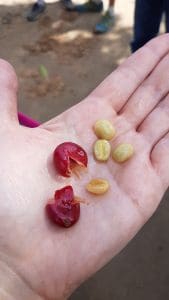
The hero of our story begins life as a berry on the green Coffea bush, shaded by the branches of the Australian Native Grevillea tree. The large Grevillea trees stand between groups of the Arabica bushes, their shade protecting the berries from ripening too fast. Harvest runs from November to March, the berries turning a bright red upon ripening. It will take about five years to get a harvest from a bush. Every couple of weeks each section will be re-harvested to get newly ripened berries. Our guide tells us to each pick two red berries from the bushes nearby and I select the two reddest I can find. Our guide walks by our outstretched hands, inspecting our efforts seriously. He tells us we can all show up for work as pickers the next morning.
He demonstrates how to hold the berries in our fists and squeeze them against each other to pop the seed from the flesh of the berry. The berry juice runs across my palm as mine dutifully pop out of their fruity protection. He explains that the berries are always picked in the morning and de-husked the same afternoon, as the flesh will ferment the bean if it is left on. He tells us to put the seed in our mouths and I find it to be surprisingly sweet. This is the layer of membrane that sits over the coffee bean, which is hard between my teeth. Under the membrane is a husk that needs to dry before it can be removed. I am unable to scrape it off with my teeth or fingernail.
The berries are used for composting or making coffee jam. The dried membrane is broken up and used as a layer in the stables as an alternative to sawdust. On this plantation nothing is wasted.
We all discard our berries in the dirt of the grove. These ones will not finish life as a cup full of rich brown goodness but perhaps become more bushes themselves.
Washing and sorting coffee beans
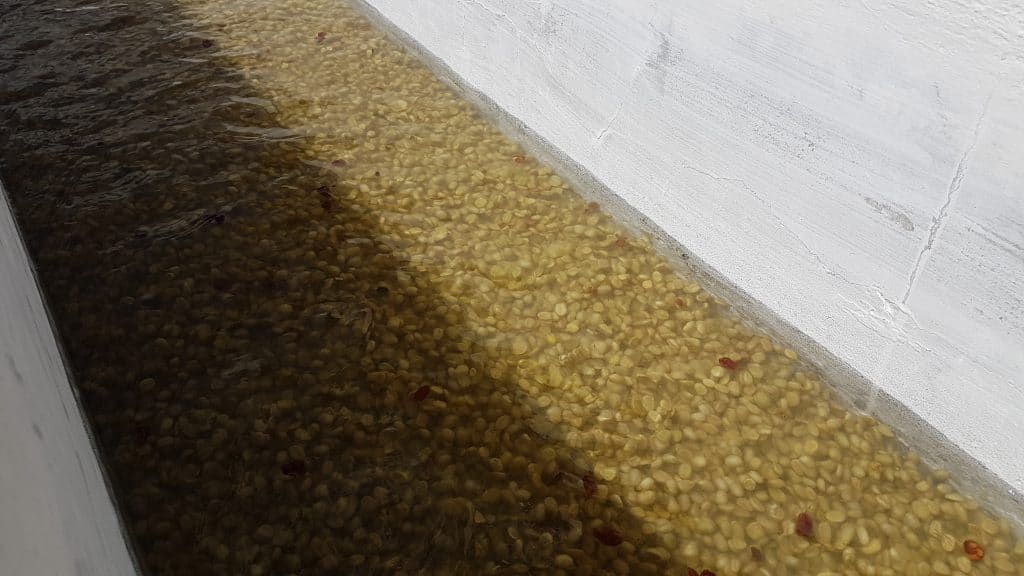
Back at the buildings, one of them turns out to be full of machinery and contraptions. One of these sends the beans swirling through channels of water. The water separates the beans from the berry while sorting according to quality. The red berries, good and ripe, will sink to the bottom while the bad or unripe fruit will float. The floating berries are used for lower quality blends of coffee while the red will make the best.
The fruit of the berry is removed by pushing them through a screen, leaving the bean surrounded by the silver skin and the parchment.
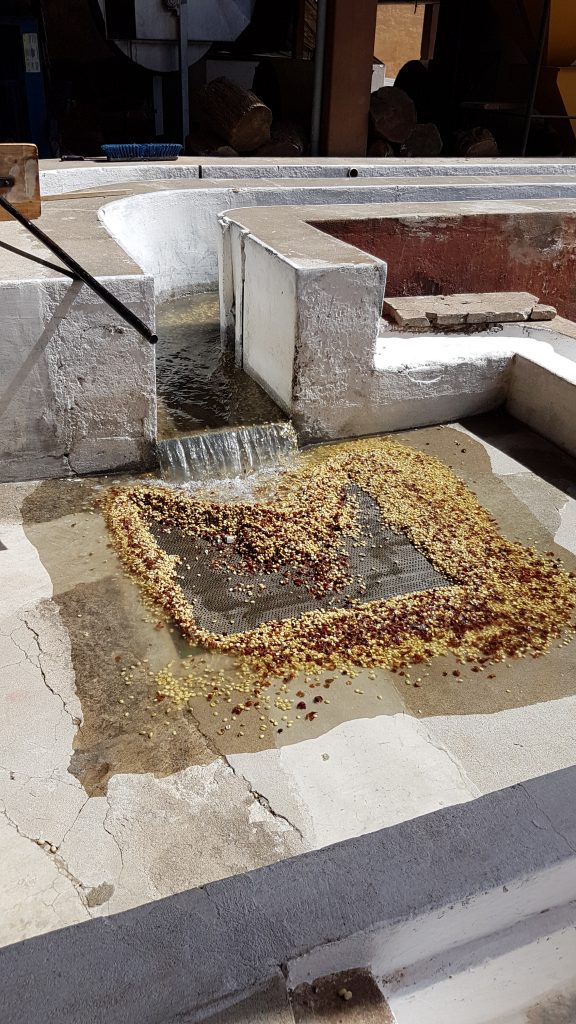
Drying Coffee beans
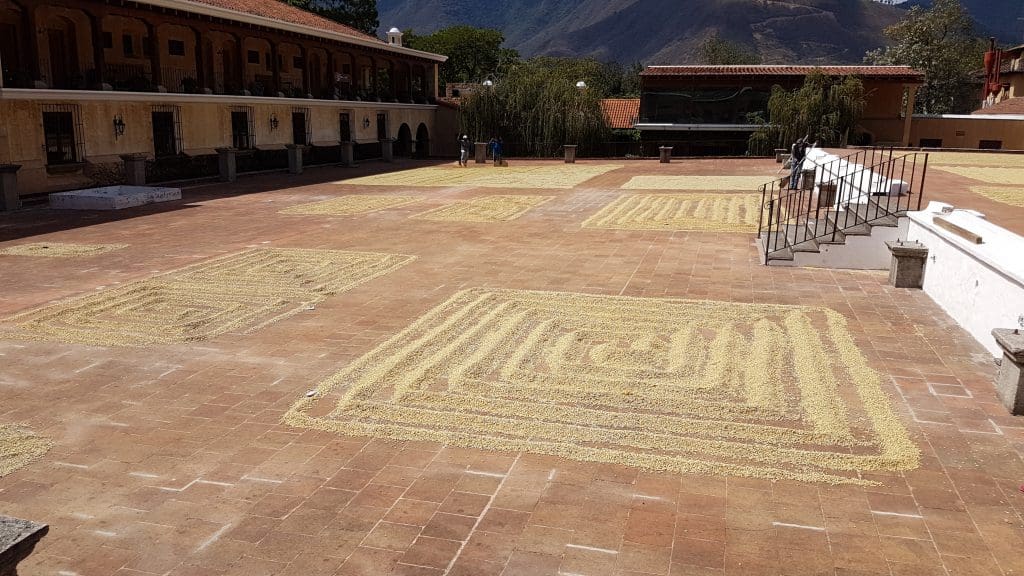
Our hero then spends several days basking in the Guatemalan sun of the Filadelfia Plantation’s courtyard while he dries and staff lovingly rake the lines of beans to ensure they dry thoroughly. They need to be raked every six hours or so to ensure they dry evenly and do not grow mildew. Since it may take up to four weeks for the beans to dry to the required moisture level for the next stage, it is fortunate that harvest season is also the dry season. This is a critical stage of the process as it will effect the quality of the end product. Over dried beans will become brittle and will break in the next stage, while beans that are too moist will be prone to attack from bacteria.
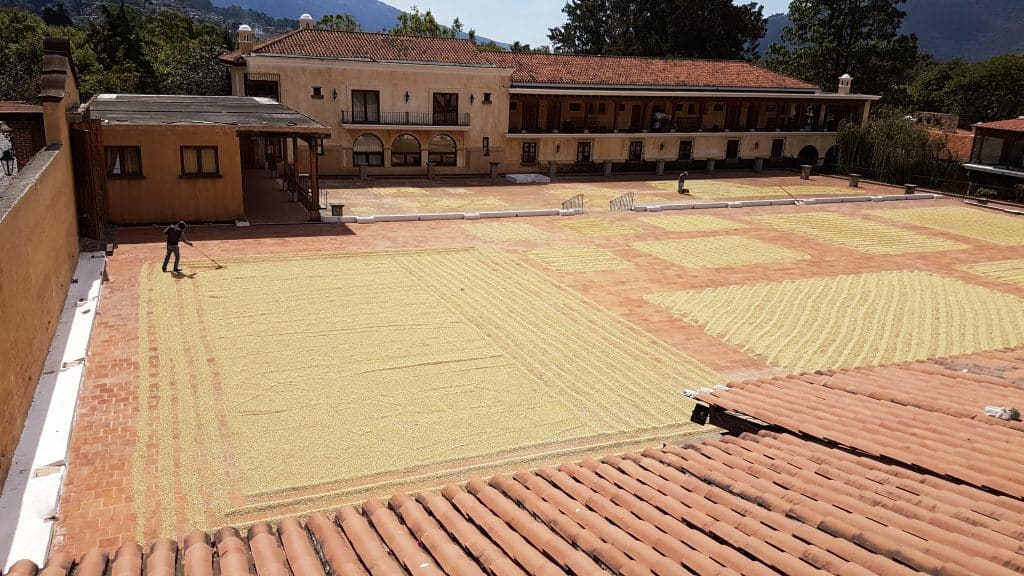
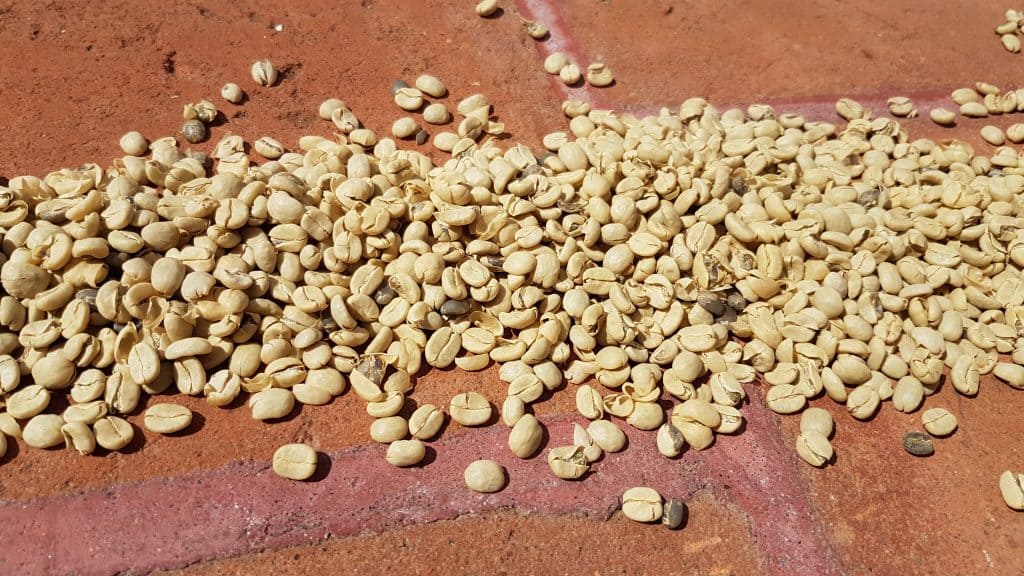
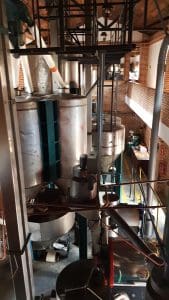
Hulling the coffee beans
Once dry he will join his fellow beans in another machine that removes the last of the fruit from the bean. In the above picture some of the beans have broken free of their husks while drying. The hulling process will leave behind the green bean which is the final product that will get exported or sold to roasters. The farm can also roast their own beans, but only do this for local sale.
By the time we get to the tasting part of the tour it is almost 1. So much for an hour tour! The coffee must be pretty good though, I don’t drink my coffee black but this one was still drinkable.
If you are interested in a tour of Filadelfia Coffee Plantation these can be purchased at any of the number of tourist stands scattered throughout Antigua. As an alternative, Intrepid run a day tour that also incorporates visits to the local markets and some of the local sites. You can book here.
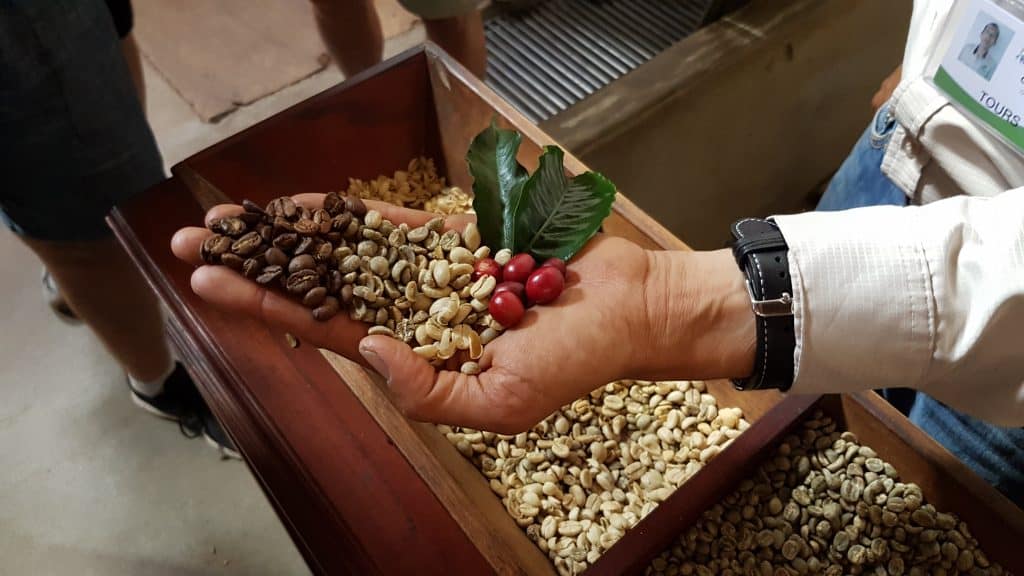
It was after 1.30 by the time I had briskly walked back to our hotel.
I found Ruth packed and ready. No one had told her to leave, and they didn’t seem at all fussed at the lateness when I went to settle the bill. The man at the front desk, who I assume was the owner/manager, asked if we had our transfer organised. I confessed, embarrassed, that we were moving to another hotel, explaining we were commencing an intrepid tour and our accommodation was included. He said he would be happy to take us there if we gave him a moment to get someone to cover him. The new hotel was across town, Ruth wasn’t 100% and we both had bags that weren’t going to be fun on a long walk. I didn’t know how we would get there yet, so I jumped at the generous offer.
He chatted with us on the way, telling us he lived out of town with his wife and daughters. The rent is too expensive for Guatemalans in Antigua, most of them live out of town and travel in. He dropped us at the door of our hotel. If you’re ever looking for a place in Antigua make sure you check out Hotel Candelaria!
I liked that our new hotel put food and water out for Antigua’s many stray dogs. And it was a short walk to Fernando’s. Still, I was glad we hadn’t spent our extra days there.
Ruth was feeling up to some activity so we head to Fernando’s for some lunch and stock up on chocolate and coffee. I am now carrying nearly two kilograms of roasted coffee beans in my pack for the rest of my trip. Not that I can actually make espresso with it when I get back until I’ve bought a new machine. I hope my bag will protect it from the heat and it survives the travels yet to come.
We then take a wander through town aiming for the chocolate museum, where the workshop we have now missed is in progress. Luckily I hadn’t booked the afternoon session, since I was still on a coffee tour. We sample some of the chocolate (not as good as Fernando’s in my opinion) and browse the artisan stands out the back. Most of it looks the same to me, but I do find a lovely soft scarf in my favourite colour that I have been keeping a watch for.
At 6.30 we take a seat in the area laid out for our introductory tour briefing. We are one of the first but one by one the chairs start to fill.
There are eleven of us all up. Mostly Australian, one older Swiss-German woman, one woman from France and an English woman. Of the Australians we are mostly teachers. Our guide is a Guatemalan woman. And there is a single, solitary man, although he doesn’t seem overly bothered by that fact!
After our briefing we head out for a group dinner and I see the first salsa dancing since leaving Mexico. I smile remembering my early days learning to dance listening to the lesson going on in the next room. As we leave to head back to our hotel I can see experienced dancers on the floor.
You can check out more tours and activities for Antigua below, including a couple of options for coffee plantation tours. You can also read about my experience hiking Volcan Pacaya and my visit to Lake Atitlan.
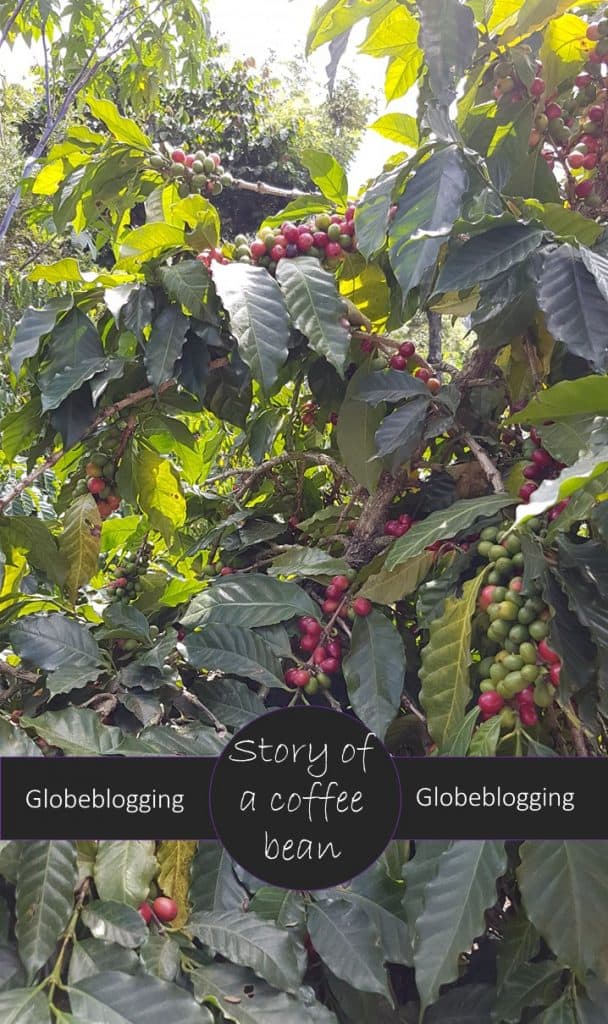
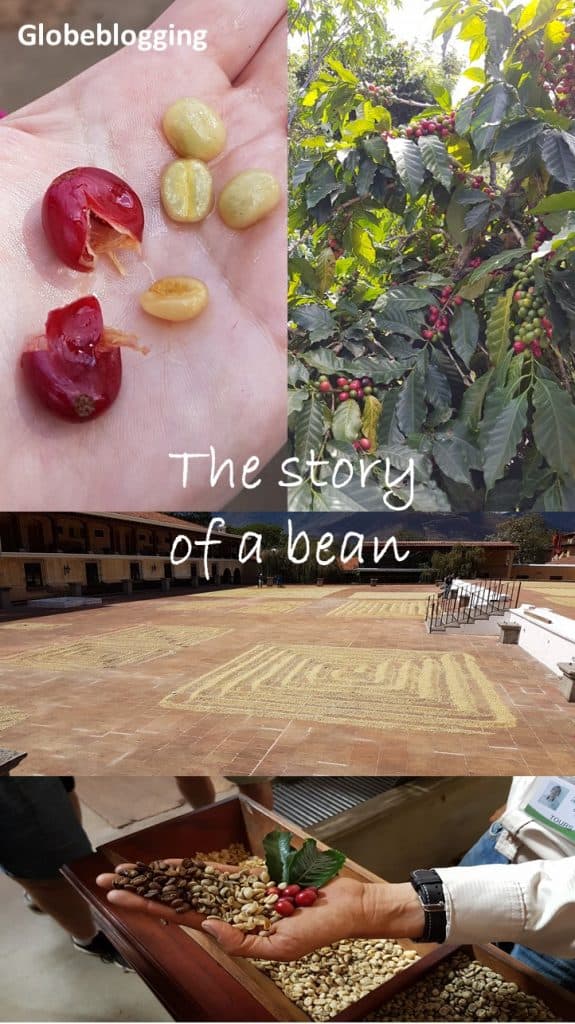

I love learning about coffee. I too could potentially drink as much as Balzac 🙂 I’ve been to a few plantations. Blue Mountains in Jamaica was my fave. Love your writing style!
Thankyou so much!
I also love coffee, and I never really knew the process of the coffee bean! I didn’t realize the coffee berries were so red! I definitely want to visit a coffee plantation when I get the chance now
I thoroughly recommend the experience!
This sounds like such a cool experience! I had no idea the coffee beans come from inside a berry! I’d love to do something like this when I visit Latin America 🙂
You totally should! The coffee in Antigua was the best I’ve ever had!
I’m so glad I found your travel blog! I never thought to write my blog post in present tense, but I absolutely love the feel! It’s as if I’m walking with you throughout your day. What a wonderful read :).
I can’t tell you how thrilled I am that you say that! Most of my blogs were written daily as I went so it was easy to be in that present tense, but its really important to me that it doesn’t just become ‘I did this and then I did that’ piece because as a reader I find that hard to connect with. I feel the present tense makes it easier to convey the experience, so I’m glad that you feel that was the case 🙂
Oh I don’t drink coffee much but this tour sounds very interesting!
It was very informative!
I LOVE coffee too and it was so cool to read this about coffee beans, thanks for sharing and welcome to Web Wednesday..!
Valerie
Thankyou for reading! I’m so glad you enjoyed it 🙂
The tour of the coffee plantation sounds really fun and interesting. I love doing tours and learning new things especially when it has to do with something I love. I am a huge coffee drinker 🙂
I think you would love a tour like this then!
WOW!! Cool to know all about Filadelfia coffee plantation. Informative one. I need a cup of coffee right now 🙂
Now is always a good time for coffee 😉
Would definitely wake up early for coffee. This is on my bucket list, to visit and taste some good coffee around the world.
I too love coffee, not black, but mainly cappuccino or better cold coffee 😀 I have heard good things about Arabica coffee, is it nice? I’m been wanting to give that a chance 😉 Well beyond my coffee preferences I would love to go on a coffee plantation tour. I think India too have some in Kerala, I’m going there for sure 🙂 Thanks for giving such detailed insights on coffee.
Yum I live for coffee! Thanks for this!
What a cool experience. Now I need a cup of coffee 🙂
bookmarked!!, I really like your web site!
I work in hospitality, mostly restaurants so I try to know the process of alot of things,. Coffee is one of them. I have seen it in Cuba and also in the Dominican Republic. This one is also sparking my senses. Hopefully to visit as soon as possible
Makes me love coffee even more, knowing how much effort goes into making it!